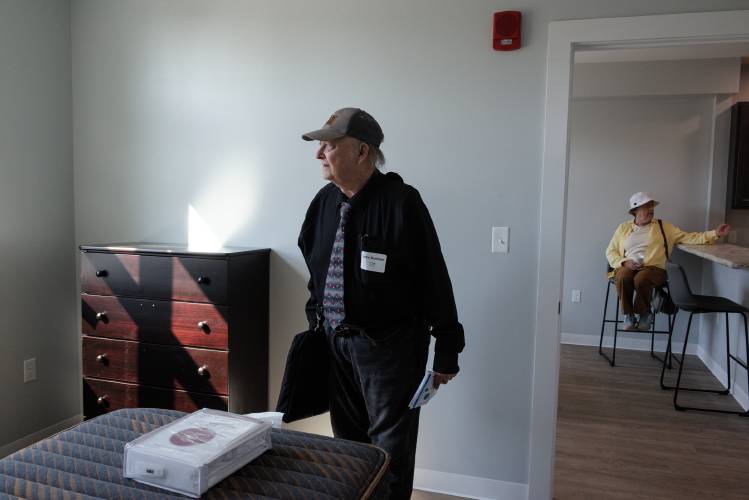This story by Emma Roth-Wells was first published in the Valley News on Sept. 5.
WHITE RIVER JUNCTION — Six people are expected to move into a new home for the chronically homeless off of Route 5 in White River Junction by the end of the month.
Their soon to be new home is a three-story, 18,000-square-foot building, with 18 one-bedroom units that neighbors both St. Paul’s Episcopal Church and Upper Valley Haven. In addition to housing, each resident will receive case management services from Upper Valley Haven, support from Twin Pines’ staff, and their own quilt made by Bugbee Senior Center residents, St. Paul’s Knit and Pearl group, and a few local neighbors.
Around 70 people attended a ribbon cutting event on Wednesday evening. Among those who spoke was U.S. Rep. Becca Balint, D-Vt.
“Housing is the foundation upon which we all try to build our lives,” Balint said in her address to the audience, “and a place like this that is situated with supports around it, means the folks living here are going to be held by the entire community and not feel like they’re in isolation.”
The project dates back to 2017 and is a collaboration between Twin Pines Housing, Upper Valley Haven and St. Paul’s. Twin Pines Housing purchased the property from St. Paul’s in 2023. Twin Pines developed the property and will continue to manage it while Upper Valley Haven staff provide social services such as employment counseling, financial guidance and mental health care to residents.
The $8.2 million project took 13 months to complete and was largely funded by the Vermont Housing and Conservation Board, Federal Tax Credit Equity and the Vermont Housing and Finance Authority.
Each unit is 494 square feet and includes an open kitchen and living room space, a bedroom and a bathroom with an accessible shower. All three floors have a common room and Haven staff offices are located on the first floor.
To qualify for a spot in this building, individuals must have experienced homelessness for at least a year or repeatedly, and have a disability. Priority will be given to those who have been living in Upper Valley Haven’s shelters and already have a relationship with the staff there, said Twin Pines Executive Director Andrew Winter.
Twin Pines Housing, St. Paul’s Episcopal Church and Upper Valley Haven are a few organizations in the Upper Valley working to combat the housing crisis. In June and August respectively, the Vermont Housing Finance Agency and New Hampshire Housing each released reports highlighting the ongoing severe shortage of affordable housing options in both states.
The Vermont report found that one-fourth of Vermont renters spend more than half of their income on housing, 20% more than what is considered affordable.
According to the New Hampshire report, only 13% of the two-bedroom rental units are affordable to the median income renter household. In order “to afford the statewide median cost of a typical 2-bedroom apartment with utilities, a New Hampshire renter would have to earn 156% of the estimated statewide median renter income, or over $73,000 a year.”
One factor contributing to high costs is a severe lack of available units. Vermont’s rental vacancy is one of the lowest in the nation at 3%, far below the 5% rate of a healthy market, according to the Vermont report.
The rising costs of construction, high interest rates on financing, and short supply of housing make it “a landlord’s market to the detriment of renters,” Winter said.
A lack of affordable housing could lead to an increase in homelessness. Vermont’s per capita homelessness rate is the second highest nationally, at 51 per 10,000 people, ahead of only New York. New Hampshire has a rate of 17 per 10,000 people as of 2022, according to the National Alliance to End Homelessness.
Ellen Hender, one of the housing and transportation program managers at Vital Communities, has worked with homeless individuals in the Upper Valley for the past decade and said she’s seen an increase in homelessness over the years.
“A lot of folks experiencing homelessness are working,” she said. “It’s just really hard to find something that fits people’s budgets.”
Tenants at the St. Paul’s property will be expected to pay rent equivalent to 30% of their income. The goal is to have the first six residents ready to be moved in by the end of the month, and the building filled by December, Haven Executive Director Michael Redmond said.
“The Haven will be able to provide supportive services that will help the new tenants to be successful and valuable members to this community,” he said.
Read the story on VTDigger here: First residents to move into White River Junction apartments for chronically homeless this month.

